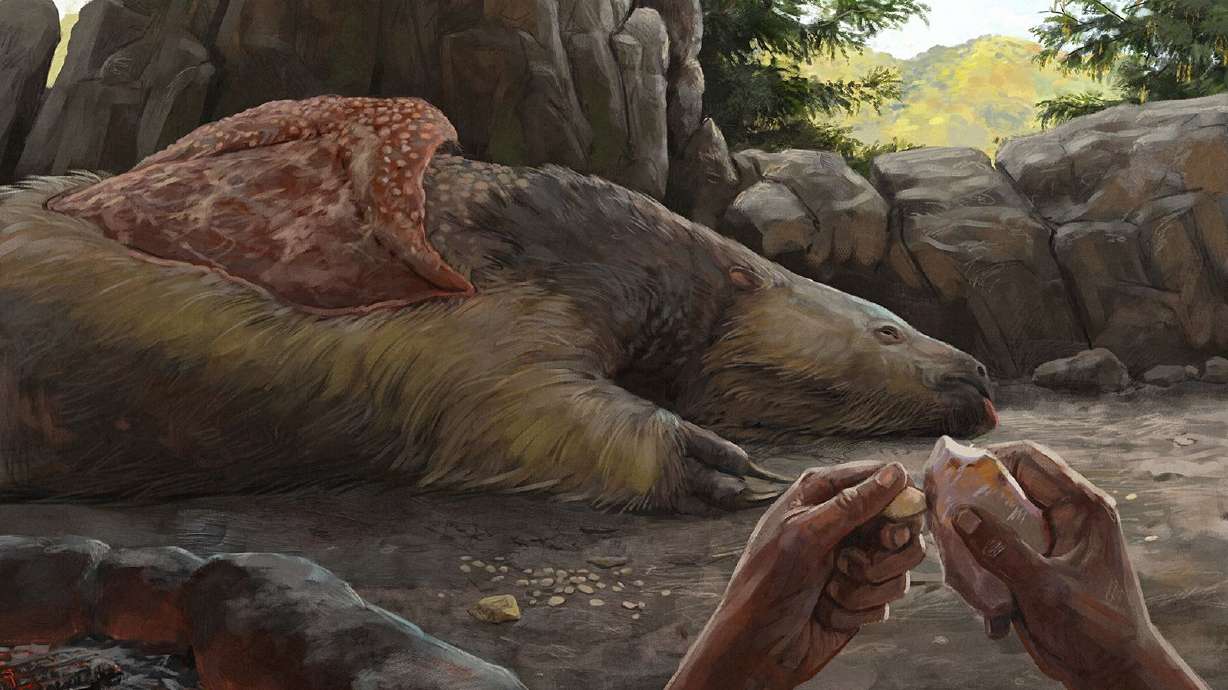Estimated read time: 4-5 minutes
This archived news story is available only for your personal, non-commercial use. Information in the story may be outdated or superseded by additional information. Reading or replaying the story in its archived form does not constitute a republication of the story.
SÃO CARLOS, Brazil — An unprecedented discovery made by archaeologists working in Brazil is shaking up what we know about the first inhabitants of the Americas.
Three giant sloth bones found at Santa Elina rock shelter in central Brazil were likely perforated and polished by human hands in order to be used for personal adornment — probably as pendants, according to a new study.
The pendants — thought to be between 25,000 and 27,000 years old — are the oldest known personal ornaments unearthed in the Americas and the only ones known to have been made from giant sloth bone in the archaeological record, according to paleontologist Thais Pansani, lead author of a new study on the artifacts. She is a postdoctoral researcher in ecology and natural resources at the Federal University of São Carlos in Brazil.
The three sloth-bone pendants were among thousands of osteoderms — bony plates embedded in the sloth's skin similar to an armadillo's scales — found at the rock shelter that belonged to an extinct species of giant sloth known as Glossotherium phoenesis. The site also features rock art of animal and humanlike forms, although the exact age of the panels is still unclear to scientists.
The ice age creature would have weighed around 1,323 pounds — bigger than most current-day brown bears. While G. phoenesis was thought to have been a relatively small species of giant sloth, some ancient sloth species were so big that their fossilized burrows are now caves in southern Brazil that humans can walk through.
Senior study author Mírian Pacheco, a professor and researcher at the Laboratory of Paleobiology and Astrobiology at the Federal University of São Carlos, said that the artifacts "present a very suggestive shape of pendants, mainly due to the polishing and the location of the hole."
The team analyzed the three modified and unmodified osteoderms and performed experiments on some of the fossilized bones and their closest modern analog — armadillo osteoderms — to understand how the pendants were made, Pacheco explained. Microscopic marks revealed that they were polished by human hands before the bones were fossilized, she said.
Pacheco said she believed humans and giant sloths coexisted at the site. A herbivore with long clawed arms designed for digging, the creature would not have preyed on humans.
"Although they had a low metabolism, they were agile animals that walked predominantly on all fours, although they could stand up (mainly to get food from trees). We cannot say if humans saw these animals as threat," Pansani said via email.
Analysis of sediment and bones
The pendants haven't been directly dated because the researchers didn't want to damage the extremely rare artifacts.
However, Pansani said the team dated other material — sediment, charcoal and other giant sloth bones — from the same layer as where the artifacts were recovered.
"All these dates agree with ages between 27,000 and 25,000 years ago, so we can infer that the age of the artifacts is in this range," Pansani said.
North and South America were the last continents to be inhabited by modern humans, but exactly when that started is a topic that has divided archaeologists. Many experts are skeptical that humans occupied the Americas any earlier than 16,000 years ago, the study noted.
However, recent evidence, including the 2021 discovery of fossilized human footprints in New Mexico that date back 21,000 to 23,000 years, suggests that early humans reached South America earlier than thought.
"The confirmation of the age of these artifacts from Santa Elina strengthens the hypothesis of older human occupations in the Americas," Pacheco said.
An international team of scientists recently unveiled a new way to extract ancient DNA from bone artifacts in a non-invasive manner. The researchers applied the pioneering technique to a pierced deer tooth found in a cave in Russia that was likely worn as a pendant. The analysis revealed the wearer's sex and other intriguing details.
For the new study, Pacheco said the team hadn't considered the possibility of trying to extract genetic material from the sloth-bone pendants.
"We are investigating some processes related to fossilization and weathering that may have caused some substitutions in bones. If we conclude that the material has a good state of preservation, then this may be a good idea," she said.
The research was published in the journal Proceedings of the Royal Society B.









